Abstract
As people’s awareness of the special functions of selenium continues to deepen, the development of selenium-rich food continues to develop, and selenium-rich places have been vigorously developing this resource-based industry. The development of selenium-rich agriculture is of great significance to improve people’s quality of life and promote agricultural, rural and regional economic development. This paper analyzes the factors affecting consumers’ willingness to purchase selenium-rich agricultural products in detail through questionnaire survey data of some consumers in Jiangxi, Ensh, Hubei and Ankang, Shaanxi, using three analytical methods of descriptive statistical analysis, factor analysis and logistic regression analysis with SPSS software. The research results show that consumers’ attitude toward selenium-rich agricultural products, price concerns, consumers’ family characteristics, health and environmental protection motives, gender and other factors have certain influence on consumers’ willingness to purchase selenium-rich agricultural products, among which the attitude factor and family characteristics have the greatest influence. Finally, the market prospect of selenium-rich agricultural products in China is analyzed and prospected, and the measures and suggestions for developing selenium-rich food are proposed in response to the problems of developing selenium-rich food in China.
1. Introduction
“Selenium is an essential trace element, which is widely found in human internal organs and has various pharmacological effects such as anti-cancer, heart protection, liver protection, preventing myopia and cataracts, detoxification, improving immunity, delaying aging and enhancing reproductive function, etc. It is known as “the fire of life“. In 1973, the World Health Organization announced the trace element “selenium“ to the world. In 1988, the Chinese Nutrition Society included the trace element “selenium” as one of the 15 dietary nutrients that our citizens must consume daily [1,2,3,4].
At present, more than 40 countries and regions around the world are deficient in selenium, and two-thirds of China is internationally recognized as a selenium deficiency area, involving 22 provinces, cities and districts, and more than 700 million people have had a serious deficiency in selenium intake for a long time, 30% of which are in severe selenium deficiency areas [5,6]. According to China’s selenium-deficient areas and human nutrition requirements, the intake of the trace element “selenium” recommended by the Chinese Nutrition Society is 50 micrograms per person per day, but the latest results of the national dietary nutrition survey show that the national per capita daily intake of selenium is 39.9 micrograms, which is less than four fifths the amount recommended by the Chinese Nutrition Society [7,8]. Therefore, from the current situation and requirements of the nutritional dietary structure of Chinese residents, selenium supplementation is an inevitable trend, and the way of selenium supplementation is mainly through dietary supplementation of selenium-rich food and medicinal supplementation of drugs and health products containing selenium. Compared with medicinal supplementation, dietary supplementation is mainly through the development of ecological organic selenium-rich agriculture, the development of ecological organic selenium-rich agricultural products, to improve the ecological organic “selenium” in the food chain. Modern medicine proves that dietary supplementation is one of the most scientific and safe ways for human to supplement selenium [9,10]. Moreover, with the continuous improvement of people’s living standards, people’s nutritional health care views are increasingly enhanced, and people not only want to eat safe, but also want to eat healthy. Selenium-rich products cater to this consumer demand and are more and more favored by consumers. Vigorously developing ecological organic selenium-rich agriculture has a broad prospect.
Developed countries have already developed selenium-rich agriculture. In addition to traditional selenium-rich crop products, in the United States, Japan, Western Europe, South Korea, Malaysia, Australia and other countries, pure natural selenium-rich livestock products such as selenium-rich milk, selenium-rich pork, selenium-rich eggs and other products have been successfully marketed [11,12]. The United States has developed pure natural selenium-rich juice, selenium-rich pasture and selenium-rich milk, and Australia has developed pure, natural selenium-rich wheat, selenium-rich beer, selenium-rich cookies, selenium-rich beef jerky and other products [13,14]. Using the rich natural soil, selenium-rich resources and ecological resources, each selenium-rich soil region in China has successfully developed pure natural selenium-rich tea, selenium-rich rice, selenium-rich wheat, selenium-rich corn, selenium-rich soybeans, selenium-rich rape, selenium-rich potatoes, selenium-rich vegetables, selenium-rich edible mushrooms, selenium-rich tea oil, selenium-rich fruits, selenium-rich pasture, selenium-rich seeds and other planting products, pure natural selenium-rich pork, selenium-rich beef, selenium-rich poultry, selenium-rich eggs, selenium-rich milk, selenium-rich aquatic products and other farming products, as well as selenium-rich gibberellic acid, Golden Partner, new Rare Treasure zinc and selenium tablets, selenium-rich Kang, selenium-rich spirulina, Anqi yeast selenium, Bao Kang selenium tablets, Kang Bi selenium and other selenium-rich health food drugs. In addition, through the use of microbial metabolism transformation biotechnology to develop ecological selenium-rich products, selenium-rich functional foods such as selenoprotein, selenium polysaccharide and other products have also made significant progress in research and development.
At present, China’s selenium-rich agriculture is better developed in areas such as Jiangxi, Hubei Enshi and Shaanxi Ankang. Various places play the “selenium-rich card”, in selenium-rich agriculture, selenium-rich green food, drinks, drugs and health products), biomedical industry, inorganic selenium industry and rehabilitation health tourism industry, increasing the development and utilization of selenium resources, and cultivating a number of leading enterprises, representing the initial formation of selenium-rich industrial clusters. Through the survey of local consumers’ willingness to purchase selenium-rich agricultural products, we gain an in-depth understanding of the actual situation of consumers’ knowledge, purchase intention and purchase behavior of selenium-rich agricultural products, and analyze the factors affecting consumers’ willingness to purchase selenium-rich agricultural products. In this paper, we put forward relevant policy suggestions to guide the government and relevant departments to formulate and promote the development of selenium-rich agricultural products and market policies and regulate the production and operation behavior of selenium-rich agricultural product producers and distributors. At the same time, during the survey, the knowledge of selenium-rich agricultural products will be publicized to the consumers to improve their awareness of selenium-rich agricultural products, increase their attention to selenium-rich agricultural products and food safety, and promote the further development of selenium-rich agricultural products in China.
2. Research Progress at Home and Abroad
Foreign research on selenium is relatively early and uneven in the field of research, focusing mainly on natural sciences, while research on economics is relatively shallow and data are scarce. Around 1950, research focused on poisoning caused by high selenium, and after 1970, research focused on the function of selenium on human nutrition and health [15]. The two stages of research are still in the exploratory stage. In 1973, the WHO first began to attach great importance to the element “selenium” and concluded that it is an essential element for the physiological function of the body [16]. The announcement of the WHO has guided research on selenium in the world. Therefore, there are more and more biological researches on selenium, and there is a great breakthrough in the application of selenium in the medical field. In general, research on selenium abroad specifically includes: research on the physiological effects of selenium on the human body, animals and plants, research on the effects of selenium on plants and agricultural products, research on the quality and safety of selenium, etc. The main research results are summarized in Table 1 below. The research time and content of foreign scholars on selenium are as follows.

Table 1.
Research Time and Content of Selenium by Foreign Scholars.
With the continuous development and maturity of the theoretical foundation of selenology abroad, people have shifted their perspectives to develop a series of selenium-enriched products involving different levels and fields [17,18]. From inorganic selenium to natural organic selenium; from natural selenium-containing crops to today’s high-tech nanoselenium, the transformation has gone through three stages: natural transformation → artificial transformation → synthetic organic selenium-rich products [19,20]. China’s selenium-rich agriculture is still in the initial stage, the corresponding research is still limited, there are not many statistics, and the economy needs less analysis. Geographically, it is mainly concentrated in selenium-rich areas, especially in the two areas of Hubei Enshi and Shaanxi Ankang, where the most research is conducted; for the research content, there are more studies on the mechanism of selenium’s physiological effects, selenium-rich production technology, selenium-rich product quality and quality and safety standards.
The following mainly summarizes the research progress of the selenium-rich industry in China and the Enshi region from the research of selenium-rich agricultural products development, selenium-rich agricultural industrialization, selenium-rich agricultural brand research, selenium-rich agricultural research and development, and selenium-rich agricultural policy research.
- (1)
- Research on the development of selenium-rich agricultural products
Research [21] divided selenium-rich products into three categories based on the biological role of selenium, natural selenium-rich products (such as selenium-rich tea, selenium-rich mineral water and selenium-rich products with added fortification of selenium such as milk drinks, dairy products, soy milk, cookies, etc.) and artificially transformed selenium-rich products produced by the microbial transformation method, plant transformation method and animal transformation method. Research [22] shows that most of the current technical content of selenium-rich foods is low, the technical level needs to be improved, and scientific proof of the transformation mechanism of selenium-rich foods is a direction of future scientific research; inexpensive and good-quality selenium-rich foods are welcomed by the market.
As the awareness of selenium supplementation for all people has not been formed, selenium-rich products are mainly for high-end consumer groups. The research [23] has come to the conclusion that people’s acceptance of selenium-rich products is roughly positively related to their income and cultural level after investigation. This provides an important reference for the marketing strategy of selenium-rich products.
- (2)
- Research on the industrialization of selenium-rich agriculture
Research [24] in the development of the Jiangxi Fengcheng selenium-rich industry proposed the development of four major industrial clusters, such as selenium-rich agricultural products, food deep-processing industry, high-tech product transformation industry and ecological tourism, to create an ecological selenium-rich industrial corridor integrating selenium-rich product production, processing, tourism and education; research [25] shows that we should establish a vertical industrial chain model, strengthen the collaboration between the upstream and midstream and downstream industries, and build the core industrial chain competitiveness.
- (3)
- Research on selenium-rich agriculture brand
Research [26] shows that regional branding operation is an advanced strategy to improve the competitiveness of the selenium-rich characteristics agriculture. Research [27] shows that in the process of regional branding development of selenium-rich agricultural products in Ankang, the regional brand operation and management mode of “government-led, chamber of commerce and association-mediated, and enterprise participant roles” should be established; the protection of “geographical indication agricultural products” should be strengthened. The study in [28] pointed out the problems of branding operations for selenium-rich products in Shaanxi: vague brand positioning, unclear brand construction actors, insufficient investment in brand construction, lack of standardization and unity in brand development, unsound service support system, and low level of brand cultivation and management. Research [29] advocates determining the brand positioning of “green, selenium-rich and healthy”, specifying that the government is the leading actor in regional brand construction, and the enterprises in the cluster are the main subjects of regional brand formation activity, advocating improving the efficiency of brand allocation and strengthening the standardization and unity of brand development. Research [30] advocates making full use of the publicity platform of the “Qingqiahui”, “Xiqiahui” and other large-scale exhibition and marketing activities inside and outside Qinghai province to promote Qinghai in a multi-angle, deep and continuous manner by holding press conferences, making exhibition boards and issuing investment guides, etc. By holding press conferences, producing exhibition boards, issuing investment guides, etc., we will promote the brand of “China’s highland ecological selenium capital” continuously. Research [31] that in the organizational form of company science and technology base (cooperative, association) farmers should be used, with the company and farmers forming a community of economic interests, risk sharing, unified production standards and joint development of the market.
- (4)
- Selenium-rich agricultural science and technology research and development
Research [32] shows that the integration of selenium-rich science and technology resources in Shaanxi Province has formed a model of science and technology innovation resources integration based on industry, led by the government and by enterprises and supported by local universities, as a platform which effectively promotes the upgrading and development of regional special industries. The Yang Xing study [33] recommends that the government, relevant scientific research units and quality inspection departments should do a good job in the census of selenium resources, development of a natural selenium-rich food labeling system, construction of a technical platform for selenium-rich resource development, development and implementation of selenium-rich food selenium content classification standards, etc., and raise funds through multiple channels to increase the financial investment for the scientific and technological support of the selenium-rich industry. Research [34] advocates to make good use of modern agricultural science and technology, combine green agricultural technology, green agricultural products processing technology, modern biotechnology and industrial equipment with cultural creativity and cultural and artistic activities, construct a multi-level pollution-free, green agricultural industry value system with regional characteristics and benign interaction with each other, and improve the market competitiveness of regional selenium-rich foods.
- (5)
- Policy research on selenium-rich agriculture
Government guidance to promote industrial upgrading is very important for the development of selenium-rich agriculture. Research [35] recommends that the government should make a comprehensive plan for the base of selenium-rich agricultural products, the layout of the selenium-rich food industry, the design of a circulation system and key development plan projects to support industrial policies, etc., to cultivate leading enterprises and promote scientific development. Research [36] advocates that the government should implement overall development with a focus according to market demand, resource ecology and industrial layout, with reference to the regional economic layout of the Enshi Prefecture, and build high-quality, high-yield, high-efficiency, ecological and safe industrial regions with characteristics in each city and district. The study in [37] advocates that the government should promote the industrialization of selenium-rich products, coordinate the relationship between the pre-production, production and post-production business entities, and provide policy, tax, financial and technical support for enterprises.
3. Structure of Consumers’ Willingness to Purchase
The development of resources should ensure sustainability and should be used reasonably [38]. On the basis of meeting existing needs, there should also be some room to ensure future development needs [39]. This requires government to regulate and allocate markets, so as to effectively allocate resources and improve utilization efficiency of resources. Through the combination of government and market, we can attach importance to property rights, update technology, clean the environment and reduce pollution. As far as selenium resources are concerned, resources stored at this stage are relatively balanced, but people have a large demand for selenium-rich resources, resulting in a large amount of development and production of selenium resources. Mining without a reasonable plan may damage the existing ecological balance and cause improper waste. Therefore, people should pay attention to the protection of the selenium resource development process, and can improve the environmental balance and promote the selenium content of organisms by assisting the use of selenium fertilizer to enhance for soil ventilation. See Figure 1 below.

Figure 1.
Selenium cycle diagram.
The theory of rational behavior holds that human behavior will be affected by behavioral attitudes and subjective norms, and ultimately behavior will affect behavior. The theoretical model of rational behavior is shown in Figure 2.

Figure 2.
Rational Behavior Theory Model.
However, people are not necessarily rational in their actual behavior process, and their behavior will also be affected by other factors. Therefore, the theory of planned behavior was proposed in 1991 based on the theory of rational behavior. The theoretical model of planned behavior is shown in Figure 3. The two models of rational behavior theory and planned behavior theory are based on the premise that individuals can make logical and reasonable decisions and conduct specific behaviors by evaluating the information available.
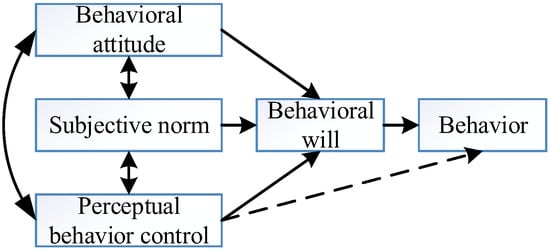
Figure 3.
Theoretical Model of Planned Behavior.
The model innovation in this paper has three points: First, many researchers classify cognition as one of the attitude variables, or ignore this variable. The study [40] found that consumers’ perceptions are influenced by the concept of environmental protection and also found that consumers’ perceptions affect two variables of trust. Therefore, in this model, cognition is regarded as a single variable, so that the formation of consumers’ purchase intention psychology can be clearer and clearer. Second, based on the theory of planned behavior and the theory of green purchase behavior, the variable of environmental awareness is introduced into the model. It is found that environmental awareness may not only affect consumers’ purchase intention, but also affect attitude variables, thus indirectly affecting their purchase intention. Third, information asymmetry theory is introduced into the model to explore the interaction mechanism among cognition, trust, attitude and purchase intention. The above three innovations can make the purchase intention model more perfect and convincing. See Figure 4 below, where, H1–H11 represents different data flows and process directions.
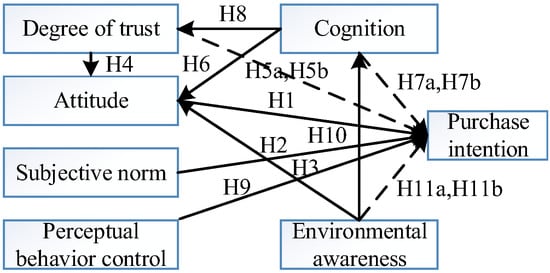
Figure 4.
Purchase Intention Model of Organic Agricultural Products.
The study [41] concluded that consumer buying behavior is the process of discovering, purchasing, using and evaluating goods to satisfy their needs and desires. This process includes both the subjective psychological activities and objective material activities of consumers. From a professional perspective, consumers’ purchase behavior is composed of a series of links, that is, consumers’ purchase behavior is a systematic purchase decision-making process (as shown in Figure 5). Many internal and external factors affect this process. In this process, purchase decisions play a major role, in which the correctness of decisions directly determines effectiveness of purchase behavior.
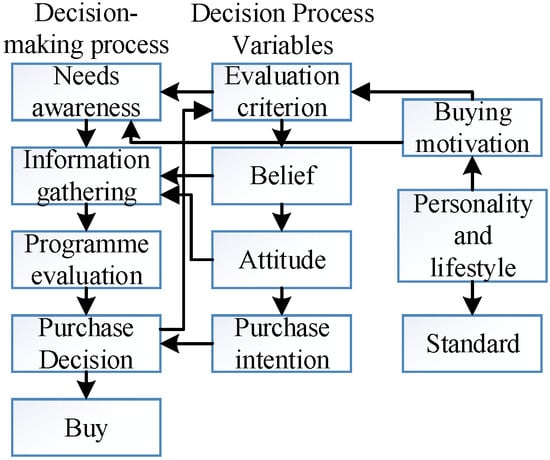
Figure 5.
Decision model of consumer purchase behavior.
Many factors have an impact on consumers’ purchase behavior, among which there are four factors that have greatest impact on consumers’ purchase behavior: consumer factors, product factors, seller factors and consumption situation factors [42]. This paper will mainly study consumer factors. The so-called consumer factors refer to social factors, cultural factors, psychological factors and personal factors that affect consumer purchase behavior, as shown in Figure 6 below.
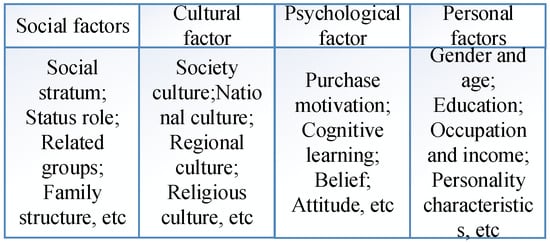
Figure 6.
Influencing Factors of Consumer Buying Behavior.
The study [43] concluded that the factors affecting consumers’ willingness to purchase selenium-enriched agricultural products can be divided into internal and external factors. Under the combined effect of both factors, factors that affect consumers’ willingness to purchase selenium-rich agricultural products are divided into four parts: personal and family factors, cognitive and attitude factors, health and environmental protection motivation factors and product and market factors. Among them, personal and family factors include consumers’ gender, age, education level, marital status, occupation, family size, family structure, family income, etc. Attitude and risk cognition factors include consumers’ demand motivation, cognition, learning, belief, evaluation, risk cognition, etc. Motivational factors for health and environmental protection include consumers’ concern for their own health and that of their families, healthy behaviors, awareness and behavior of protecting the natural ecological environment, etc. These factors constitute internal factors that affect consumers’ purchase intention and play a role in consumers’ purchase intention through internal influence. In addition, product and market factors of selenium-rich agricultural products include the quality and safety of selenium-rich agricultural products, selenium-rich certification, nutrition, taste, packaging, price, channel, convenience, promotion, communication, etc. These factors constitute external factors that affect consumers’ willingness to purchase selenium-rich agricultural products, and play a certain role in consumers’ purchase behavior through external influence. See Figure 7 below.
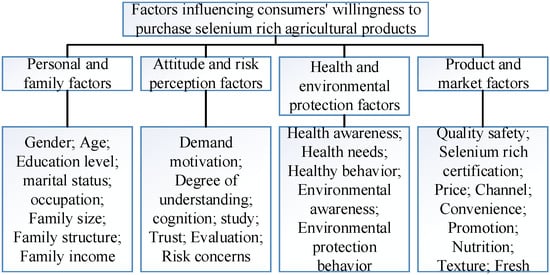
Figure 7.
Factors influencing consumers’ willingness to buy enough organic agricultural products.
This paper proposes a theoretical model as shown in Figure 8. The whole model consists of three parts: (1) How product attributes, product knowledge, shopping atmosphere, price sensitivity and green awareness affect consumers’ purchase attitude towards green agricultural products; (2) How purchasing attitude affects consumers’ willingness to buy green agricultural products; (3) The moderating effect of purchase channels on product attributes, product knowledge, shopping atmosphere, price sensitivity, green awareness and consumers’ attitudes towards purchasing green agricultural products, among which purchase channels mainly select supermarkets and farmers’ markets where consumers choose to purchase green agricultural products more frequently for comparative research.
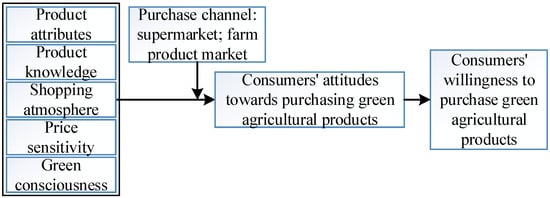
Figure 8.
Theoretical Model.
The technical route of this paper is shown in Figure 9 below.
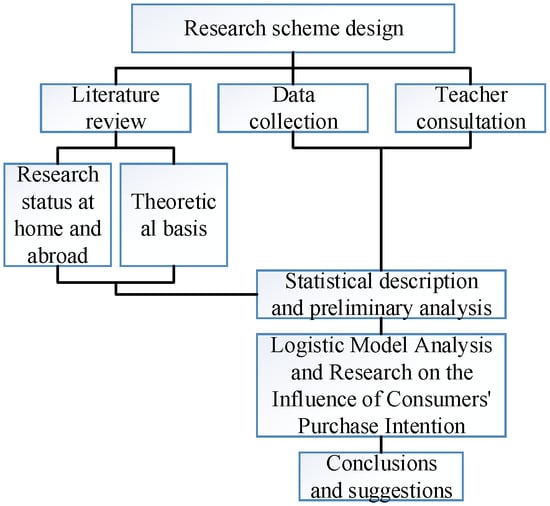
Figure 9.
Technical Roadmap.
4. Logistic Regression Algorithm
A logistic regression model is a probabilistic nonlinear regression model, and also an analysis method of multivariable relationships [44]. It is intended to explain the relationship between classification results, that is, dependent variable p, and multiple influencing factors, that is, independent variable x. The basic principle of logistic regression analysis is to use a set of data to fit the logistic regression model, which is used to reveal the relationship between a number of independent variables x and a dependent variable p value, reflecting interdependence between p and x. A logistic regression model can effectively limit the range of dependent variables to [0, 1], so it is particularly suitable for studies where the dependent variable is a binary variable. In the study conducted in this paper, the dependent variable of consumers’ willingness to buy selenium-rich agricultural products is “yes” or “no”, and number is “0” or “1”, so this paper intends to use a logistic regression model for analysis.
Logistic regression analysis model is:
After transforming Equation (1), Equation (2) is obtained:
Empirical model of consumers’ willingness to purchase organic agricultural products: .
Among them, Y is consumer’s willingness to purchase selenium-rich agricultural products. In this model, there are four factors that affect consumer’s willingness to purchase selenium-rich agricultural products: is consumer’s personal and family factors, is consumer’s attitude towards selenium-rich agricultural products and risk perception factors, is consumer’s health and environmental protection motivation factors, and is product and market factors of selenium-rich agricultural products. Each aspect of factors is reflected by several specific variables. There are 22 such variables, and results of these 22 variables are all from the questionnaire.
Y = 0 means consumers have no intention to purchase selenium-rich agricultural products, and Y = 1 means consumers have intention to purchase selenium-rich agricultural products.
In above formula, represents gender of consumer, represents age of consumer, represents education level of consumer, represents marital status of consumer, represents occupation of consumer, represents family size of consumer, represents whether there are elderly or children in family structure of consumer, and represents monthly family income of consumer.
In above formula, represents understanding degree of selenium-rich agricultural products, represents trust degree of selenium-rich agricultural products, represents evaluation degree of selenium-rich agricultural products, and represents risk awareness degree of food safety.
In above formula, represents degree of consumers’ concern for environmental protection, and represents degree of consumers’ concern for health.
In above formula, represents quality and safety of selenium-rich agricultural products, represents price level of selenium-rich agricultural products, represents nutrient richness of selenium-rich agricultural products, represents freshness of selenium-rich agricultural products, represents health and environmental protection of selenium-rich agricultural products, represents selenium-rich certification of selenium-rich agricultural products, represents convenience of purchasing selenium-rich agricultural products, and represents publicity level of selenium-rich agricultural products.
In this way, we will establish specific logistic regression equation as follows:
In this formula, p represents probability that consumers are willing to buy selenium-rich agricultural products, which is a dependent variable. It represents whether consumers are willing to buy selenium-rich agricultural products, where 1 represents willing to buy, and 0 represents unwilling to buy; is used to represent regression coefficient of each influencing factor; N represents number of regression factors; is an independent variable, representing influencing factor; is constant of regression equation.
So, we can establish logistic model as follows:
If probability of predicted value p is greater than 0.5, sample will be classified into willing to buy group. On contrary, if probability of predicted value p is less than 0.5, sample will be classified into unwilling to buy group.
5. Results
A total of 220 questionnaires were distributed and 209 were returned. Discounting invalid questionnaires that consumers missed or had obvious problems, there were 186 valid questionnaires, with an effective sample rate of 88.99%. This basically conforms to sample size selection criteria for a social survey, so the survey results of the questionnaire are also valid.
(1) Gender. From the perspective of gender distribution, there were 90 males in 186 valid samples, accounting for 48.39% of valid samples, and 96 females, accounting for 51.11% of valid samples, of which the proportion of females was basically the same. Generally, we think that in family life, women usually take main role in food purchasing, so women are also the majority of consumers purchasing selenium-rich agricultural products. However, according to a previous analysis of this paper, the impact of gender on consumers’ willingness to purchase selenium-rich agricultural products is uncertain, so we did not deliberately choose women for the survey sample as some surveys did, and the gender ratio is quite meaningful. (2) Age distribution. In survey results, the range of the age distribution was large, ranging from 20 years old to over 60 years old. In the questionnaire design, respondents were divided into four age groups, including 1 person under 20 years old, accounting for 0.5% of the valid sample, 112 people between 20 and 40 years old, accounting for 60.22% of the valid sample, 70 people between 40 and 60 years old, accounting for 37.63% of the valid sample, and 3 people over 60 years old, accounting for 1.61% of the valid sample. Among them, the number of people under 20 and over 60 years old was small, and consumers under 20 years old are not mainly responsible for purchasing agricultural products in their families, so they should be avoided as much as possible in investigating the sample selection process. Due to the limitation of education level and vision, the elderly over 60 years old had difficulty in understanding the contents of the questionnaire, which investigators were required to explain item by item during the survey, which was very time-consuming and energy-consuming, so they represent a small proportion in the sample selection. (3) Education level. From perspective of education level, distribution of educational background was relatively concentrated. There were only 17 people with junior high school education or below, accounting for 9.14% of the valid sample. There were 40 people with senior high school education or technical secondary school education, accounting for 21.51% of the valid sample. There were 95 people with university education or college education, accounting for 51.1% of the valid sample. There were 34 people with a master’s degree or above, accounting for 18.28% of the valid sample. On the whole, most of respondents had a high educational background, with 70.4% of respondents having a college degree or above and 29.6% of respondents having a high school education or below. (4) Marital status. In terms of marital status, the number of unmarried people was 54, accounting for 29.03% of the valid sample, and the number of married people was 132, accounting for 70.97% of the valid sample. Among them, the number of married people was significantly higher than unmarried people, because they tended to be over 20 years old in age distribution, and married people account for majority of these people. When married people assume responsibility for purchasing in the family, they will consider the health and nutrition needs of their families, which is consistent with fact. (5) Occupation. From perspective of occupational distribution, the questionnaire distinguished six main options, including only 10 unemployed people, accounting for 5.4% of valid sample, 9 self-employed people, accounting for 4.84% of the valid sample, 70 employees of private enterprises, accounting for 37.63% of the valid sample, 40 employees of state-owned enterprises and public institutions, accounting for 21.50% of the valid sample, 10 civil servants, accounting for 5.38% of the valid sample, and 46 others, accounting for 24.73% of the valid sample. In the whole sample distribution, the proportion of employees in private enterprises, state-owned enterprises and public institutions was relatively high. After inquiry, a small number of respondents who filled other occupations were foreign enterprise employees, and the others were freelancers and college students. See Table 2 below.

Table 2.
Statistics of Basic Personal Information of Respondents.
(1) Family size. In the questionnaire, we used characteristics of the family population to represent family size, and set three segments, including 23 families with two or fewer people, accounting for 12.37% of the sample, 147 families with three to four people, accounting for 79.03% of the sample, and 14 families with five or more people, accounting for 7.53% of the sample. In terms of overall distribution, 3–4 families account for largest proportion, which is consistent with the actual situation of respondents. (2) Family structure. In setting the variable of family structure, we distinguished whether there were elderly or children in the family. A total of 86 respondents had elderly or children in their families, accounting for 46.24% of the sample, and 100 respondents had no elderly or children in their families, accounting for 53.76% of the sample. The reason for choosing this variable is that if there are elderly and children in the family, the family will consider the impact of goods on the health and safety of the elderly or children when purchasing goods, which will affect consumers’ purchase intentions. (3) Family income. We used the average monthly income of families to express this variable. The average monthly income of respondents was widely distributed, and we divided it into six sections, including 20 families with a monthly income of less than CNY 2000, accounting for 10.75% of the sample; there were 40 families with a monthly income of CNY 2000–4000, accounting for 21.50% of the sample; there were 76 families with a monthly income of CNY 4000–6000, accounting for 40.86% of the sample; there were 20 families with a monthly income of CNY 6000–8000, accounting for 10.75% of the sample; there were 19 families with a monthly income of CNY 8000–10,000, accounting for 10.21% of the sample; there were 11 families with a monthly income of more than CNY 10,000, accounting for 5.91% of the sample. Among them, the number of families with a monthly income of CNY 4000–8000 reached 96, accounting for 51.6% of the sample, which basically conforms to the distribution of residents’ income levels. See Table 3 below.

Table 3.
Statistics of basic family information of respondents.
Food safety problems now occur frequently in society, and food safety problems are reported from time to time throughout country. People pay more and more attention to food safety, even to an unprecedented extent. We used a Likert scale to measure consumers’ concern about food safety issues. The five level scale is divided into: 1 = not concerned; 2 = not much attention; 3 = general concern; 4 = relatively concerned; 5 = very concerned. Among the sample, 51 people were very concerned, 77 people were more concerned and 42 people were generally concerned; the number of people who chose these three options accounted for 91.4% of sample, which means that more than 90% of respondents showed concern about food safety. In addition, 15 people did not pay much attention to food safety, and only one person did not pay attention to food safety at all. This shows that food safety has been popularized, and almost no one does not pay attention. See Figure 10 below.
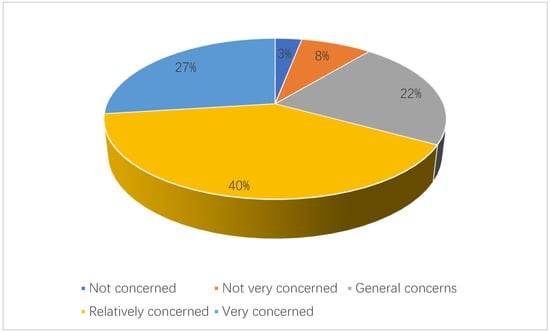
Figure 10.
Consumers’ attention to food safety.
The same method was used to conduct a statistical analysis on the degree of consumers’ concern for their own and their families’ health and degree of consumers’ concern for environmental protection. The number of consumers who paid close attention to their own health and their families’ health reached 88, accounting for about half of respondents, and the number of consumers who paid close attention to their own health and that of their families reached 72 and 23, respectively, accounting for 38.7% and 12.4% of sample, respectively. Only three people who deserved attention choose not to pay close attention to their own health and that of their families. This fully shows that in today’s society, with improvement of living standards, people pay much attention to their own and their families’ health. On the issue of consumers’ attention to environmental protection, 15 people chose to pay great attention, 95 people chose to pay more attention, and 63 people chose to pay general attention. These three kinds of people accounted for 91.9% of the sample, and only 8.1% chose not to pay much attention or not to pay attention, indicating that people also pay high attention to environmental protection, but compared with health and safety, the proportion of people who pay much attention to environmental protection is still small. See Figure 11 below.
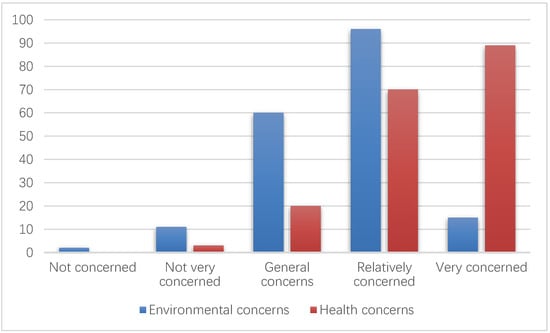
Figure 11.
Consumers’ Concern for Health and Environmental Protection.
In order to understand consumers’ understanding and cognition of selenium-rich agricultural products, we gathered statistics through a questionnaire survey. According to the survey results, the number of people who did not know or knew a little about selenium-rich agricultural products reached 37 and 99 respectively, accounting for 19.9% and 53.2% of total number of respondents, respectively, accounting for about three quarters of the sample number. This shows that most consumers still have a low understanding of selenium-rich agricultural products. The number of people who generally knew about selenium-rich agricultural products was 31, accounting for 16.7% of the sample number, and number of people who were relatively familiar with selenium-rich agricultural products was 17, accounting for 9.1% of the sample number. Only two people know selenium-rich agricultural products very well, only 1.1% of the sample number. This result is far from that of foreign countries. It may be that most people, as ordinary consumers, think that selenium-rich agricultural products are luxury goods. At the initial stage of development of the selenium-rich agricultural products market, only a few people know about selenium-rich agricultural products. See Figure 12 below.
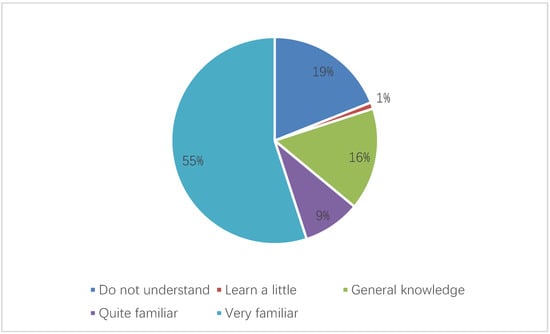
Figure 12.
Consumers’ understanding of organic agricultural products.
In the survey on consumers’ trust in selenium-rich agricultural products, only 1.1% of consumers expressed their strong trust in selenium-rich agricultural products, 7.5% of consumers expressed their trust in selenium-rich agricultural products, and 34.4% of consumers generally believed in selenium-rich agricultural products. The proportion of people who choose these three results was improved compared with consumers’ understanding of selenium-rich agricultural products. In addition, 39.2% of consumers did not trust selenium-rich agricultural products, and 17.7% of consumers do not trust selenium-rich agricultural products at all. Compared with consumers’ understanding of selenium-rich agricultural products, the degree of distrust of selenium-rich agricultural products decreased. This result may be due to the high price and market positioning of selenium-rich agricultural products, and consumers feel that selenium-rich agricultural products are trustworthy based on their experience of paying for everything. See Figure 13 below.

Figure 13.
Consumer trust in organic agricultural products.
In addition, in the survey of consumers’ evaluation of selenium-rich agricultural products, 1.1% of consumers thought that the quality of selenium-rich agricultural products was very good, 13.4% of consumers thought that the quality of selenium-rich agricultural products was good, giving a total of only 14.5% of consumers for these two proportions, which shows that there are not many consumers who have high evaluation of selenium-rich agricultural products. A total of 68.3% of consumers thought that the quality of selenium-rich agricultural products was average, which accounts for a large proportion. This may be because some consumers do not feel that the quality of selenium-rich agricultural products is superior to ordinary agricultural products, so they cannot make comments on them and can only choose the same quality. The proportion of poor and bad parity for selenium-rich agricultural products was 11.8% and 5.4%, respectively, which is also small. The questionnaire also designed a question to find what effect consumers think long-term consumption of selenium-rich agricultural products has on health to further analyze consumers’ parity of selenium-rich agricultural products. The proportion of consumers who though that the effect was very good and good was 4.8% and 30.1%, respectively, while the proportion who thought that effect was average was 38.7%, and the proportion of consumers who chose some effect and no effect was 17.7% and 8.6%, respectively. In process of evaluating the effect of selenium-rich agricultural products, consumers were conservative, probably because most consumers have not been eating selenium-rich agricultural products for a long time, so they can only make such an evaluation. See Figure 14 below.
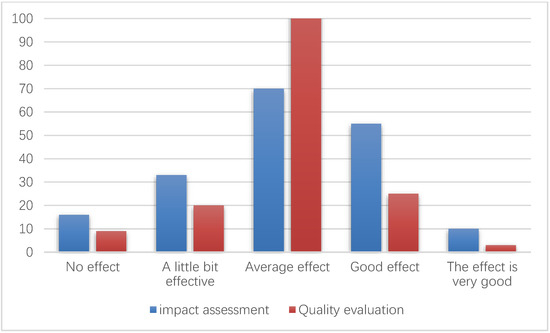
Figure 14.
Frequency comparison of consumers’ quality evaluation and effect evaluation of organic agricultural products.
This paper mainly studied consumers’ willingness to buy selenium-rich agricultural products. This question was posed directly in the questionnaire. Of 186 valid samples, 149 people chose to buy, which accounted for 80.1% of the total, and 37 people chose not to buy enough, which only accounted for 19.1% of the total, a small proportion. This shows that, today, with frequent food safety problems, most consumers are willing to buy agricultural products with a high level of safety such as selenium-rich agricultural products. Regarding the problem of the higher cost of selenium-rich agricultural products, 51.6% of consumers were willing to pay a premium of less than 20%, 38.7% chose 20–40%, 3.8% chose 40–60%, no consumer chose 60–100%, and only 5.9% chose not to consider price factors. From the results, it can be seen that more than half of consumers can accept a premium of less than 20%, which is directly related to the consumption level of most consumers. Of course, there are also consumers who do not care about price. On one hand, consumers are more interested in healthy and environment-friendly consumption motives, and on other hand, they are different in consumption levels. See Figure 15 and Figure 16 below.

Figure 15.
Consumers’ willingness to purchase organic agricultural products.
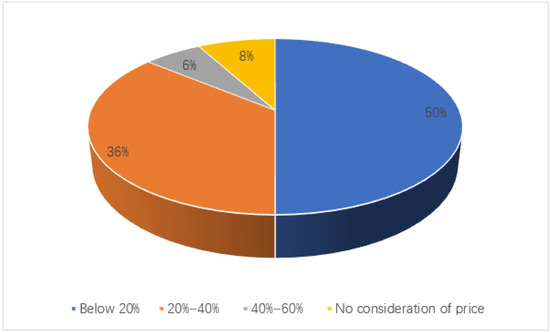
Figure 16.
Premium acceptable to consumers.
According to statistics on the frequency of consumers buying selenium-rich agricultural products, 17.7% of consumers never bought selenium-rich agricultural products, 76.4% of consumers occasionally bought selenium-rich agricultural products, and only 5.9% of consumers often bought selenium-rich agricultural products. This shows that selenium-rich agricultural products cannot become daily consumer goods for the majority of consumers in the same way as ordinary agricultural products. Only a small number of consumers had the will and ability to regularly consume selenium-rich agricultural products. In addition, the types and quantities of selenium-rich agricultural products on the market are also very limited, unlike wholesale sales of ordinary agricultural products, so there are fewer consumers who can buy them often. The products and market information of selenium-rich agricultural products are described as follows (Table 4): among consumers, 10.75% chose to buy selenium-rich agricultural products from farmers’ markets, while most ordinary farmers’ markets do not sell selenium-rich agricultural products, which affects the convenience of buying enough. Therefore, 6.99% of consumers thought it was inconvenient or quite inconvenient to buy selenium-rich agricultural products. In addition, 6.5% of consumers thought that the publicity of selenium-rich agricultural products was very small, and 36.5% of consumers thought that the publicity of selenium-rich agricultural products was relatively small. In terms of the proportion of people, because government or dealers give little publicity to selenium-rich agricultural products, some consumers did not understand the functional characteristics of selenium-rich agricultural products, which also affects consumers’ purchase intentions to a certain extent. See Figure 17 below.

Table 4.
Statistical table of consumers’ description of organic agricultural products and market conditions.
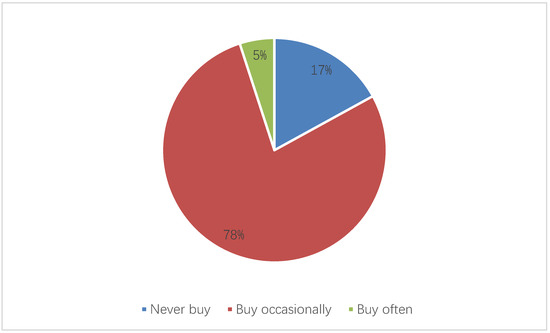
Figure 17.
Consumers’ purchase frequency of organic agricultural products.
This paper used logistic regression analysis to process and analyze the questionnaire data of consumers’ willingness to purchase selenium-rich agricultural products, and obtained the following conclusions: (1) According to the data processing results, the proportion of consumers who have a purchase intention for selenium-rich agricultural products has reached 80.1%, which is basically consistent with the proportion of 82.3% who actually exhibit purchase behavior (occasional purchase and frequent purchase). However, only 5.9% of consumers often buy selenium-rich agricultural products, indicating that the purchasing power of consumers for selenium-rich agricultural products is insufficient, and the development of the selenium-rich agricultural products industry needs to be further promoted. (2) Consumers’ attitude towards selenium-rich agricultural products has an impact on consumers’ willingness to buy selenium-rich agricultural products. The more positive consumers’ attitudes towards selenium-rich agricultural products, the stronger the willingness to purchase. However, in the actual survey, only 8.6% of consumers expressed relative or great trust, and 14.5% of consumers thought selenium-rich agricultural products were relatively good or very good. Consumers’ low trust and evaluation of selenium-rich agricultural products directly lead to low willingness to purchase selenium-rich agricultural products, which affects the market development of selenium-rich agricultural products, and consumers’ trust in selenium-rich agricultural products needs to be further improved [45]. (3) The family characteristics of consumers influence consumers’ purchase of selenium-rich agricultural products. Consumers’ family size, whether there are old people or children in the family structure, family income and purchase intention have an impact on consumers. The larger the family size, whether there are old people or children in the family, and the higher the family income, the stronger the consumers’ willingness to purchase selenium-enriched agricultural products. (4) Consumer health and environmental motivation factors have an impact on consumers’ willingness to purchase selenium-enriched agricultural products. Consumers’ environmental and health motivation factors include consumers’ concern for their own and their family’s health, concern for environmental protection and concern for food safety. The higher the consumer’s concern, the stronger the willingness to purchase selenium-rich agricultural products. The proportion of consumers who are more concerned about health, environmental protection and food safety reaches 86%, 59.2% and 68.8% respectively, which has a positive impact on consumers’ willingness to purchase selenium-rich agricultural products. (5) The gender and cognitive factors of consumers have an impact on consumers’ willingness to purchase selenium-rich agricultural products. Among them, male consumers are more willing to buy selenium-rich agricultural products. The higher the consumers’ knowledge of selenium-rich agricultural products, the stronger the willingness to buy selenium-rich agricultural products. However, 73.1% of consumers know little or very little about selenium-rich agricultural products, which leads to consumers’ reluctance to buy selenium-rich agricultural products. Therefore, it is necessary to widely publicize selenium-rich agricultural products so that more consumers can understand selenium-rich agricultural products. (6) Consumers’ concern about the price of selenium-rich agricultural products has an impact on consumers’ purchase of selenium-rich agricultural products. The higher the concern of consumers about the price of selenium-rich agricultural products, the lower the price premium, compared with ordinary agricultural products, consumers are willing to pay for selenium-rich agricultural products. A total of 62.9% of consumers are concerned or very concerned about the price; 90.3% of consumers can only accept less than a 40% premium for selenium-rich agricultural products compared with ordinary agricultural products, which further indicates that the price has a great impact on consumers’ decisions to buy selenium-rich agricultural products, which should expand the production scale of selenium-rich agricultural products and reduce the price of selenium-rich agricultural products.
6. Conclusions
From the elaboration and analysis of this paper, we can learn that it is especially necessary to systematically analyze and consider consumers’ willingness to purchase selenium-rich agricultural products, which has certain research significance and practical value. By analyzing the current consumers’ willingness to purchase selenium-rich agricultural products, this paper proposes effective strategies for the industrialization of selenium-rich agriculture: building a scientific R&D management platform, accelerating the speed of scientific and technological innovation, creating demonstration bases, shaping selenium-rich brands, compiling scientific selenium-rich standards, clarifying relevant supporting technical regulations, highlighting the leading role of leadership, and increasing the support of relevant policies. It is hoped that the content and results of this research and analysis can attract the attention of research staff towards the industrialization development of selenium-rich agriculture, and obtain the corresponding inspiration and help from them, so as to enhance the actual effect of the industrialization development of selenium-rich agriculture, and then accelerate the speed of the industrialization development of selenium-rich agriculture in China.
Author Contributions
Conceptualization, L.Z. and R.G.; methodology, R.G.; software, R.G.; validation, H.Z., X.L. and Z.S.; formal analysis, L.Z.; investigation, X.L.; resources, Z.S.; data curation, L.Z.; writing—original draft preparation, X.L.; writing—review and editing, R.G.; visualization, X.L.; supervision, H.Z.; project administration, L.Z.; funding acquisition, H.Z. All authors have read and agreed to the published version of the manuscript.
Funding
This research was funded by the Ministry of Education, Humanities and Social Sciences Project (grant number: 22YJCZH150); Projects Supported by Jiangxi Provincial Social Science Foundation (grant number: 21GL47); Humanities and Social Science Project of Jiangxi Province (grant number: 21Y02742).
Institutional Review Board Statement
Not applicable.
Informed Consent Statement
Not applicable.
Data Availability Statement
The experimental data used to support the findings of this study are available from the corresponding author upon request.
Acknowledgments
The authors would like to show sincere thanks to those technicians who have contributed to this research.
Conflicts of Interest
The authors declared that they have no conflict of interest regarding this work.
References
- Liao, Q.; Liang, P.; Xing, Y.; Huang, T.; Liu, Y.; Jiang, Z. Isolation and identification of selenium-tolerant strains from selenium-rich soil in Guangxi. Agric. Biotechnol. 2018, 7, 126–129+136. [Google Scholar]
- Mllers, J.; Dufhues, T.; Buml, T. Understanding the market potential of products from alternative food networks in a transition economy—A discrete choice experiment. Br. Food J. 2022, 124, 183–199. [Google Scholar] [CrossRef]
- Ying, X.I.; Yongxian, L.I.; Liang, P.; Qing, L.I.; Liping, P.A.; Huang, T.; Jiang, Z. Form and interconversion factor of selenium in soil. Agric. Biotechnol. 2019, 8, 120–124. [Google Scholar]
- Li, X.; Luo, Y.; Zeng, C.; Zhong, Q.; Xiao, Z.; Mao, X.; Cao, F. Selenium accumulation in plant foods and selenium intake of residents in a moderately selenium-enriched area of Mingyueshan, Yichun, China. J. Food Compos. Anal. 2022, 116, 105089. [Google Scholar] [CrossRef]
- Chen, S.; Liu, L.; Tang, D. Determination of total and inorganic selenium in selenium-enriched rice, tea, and garlic by high-performance liquid chromatography-inductively coupled plasma mass spectrometry (HPLC-ICP-MS). Anal. Lett. 2021, 54, 1809–1825. [Google Scholar] [CrossRef]
- Dinh, Q.T.; Wang, M.; Tran, T.A.T.; Zhou, F.; Wang, D.; Zhai, H.; Peng, Q.; Xue, M.; Du, Z.; Bañuelos, G.S.; et al. Bioavailability of selenium in soil-plant system and a regulatory approach. Crit. Rev. Environ. Sci. Technol. 2019, 49, 443–517. [Google Scholar] [CrossRef]
- Liu, N.; Wang, M.; Zhou, F.; Zhai, H.; Qi, M.; Liu, Y.; Li, Y.; Zhang, N.; Ma, Y.; Huang, J.; et al. Selenium bioavailability in soil-wheat system and its dominant influential factors: A field study in Shaanxi province, China. Sci. Total Environ. 2021, 770, 144664. [Google Scholar] [CrossRef]
- Mei, Z.Q. Summary on two Se-rich areas of China. Chin. J. Endem. 1985, 4, 379–385. [Google Scholar]
- Zhou, J.; Zhang, D.; Ren, W.; Weishi, Z. Auto Color Correction of Underwater Images Utilizing Depth Information. IEEE Geosci. Remote Sens. Lett. 2022, 19, 1504805. [Google Scholar] [CrossRef]
- Huang, W.; Minying, S.H.; Zhaoliang, L.I.; Zhang, Y.; Daobo, W.A. Effects of different application methods and application rates of biological nano-selenium on the quality of passion fruit. Med. Plant 2020, 11, 72–73+96. [Google Scholar]
- Xiu, L.; Dongmei, W.; Liping, P.; Jinping, C.; Mengling, N.; Zhilian, F.; Ying, X.; Yongxian, L. Standardized production technology of selenium-enriched Hylocereus undatus (pitaya) in natural selenium-rich areas. Agric. Biotechnol. 2020, 9, 44–46. [Google Scholar]
- Qiang, L.I.; Jing, Z.; Yang, R.; Gao, Z.; Shan, J.; Liang, P. Evaluation and exploration of se-enriching effects of microbial nano-selenium on several kinds of vegetable. Agric. Biotechnol. 2018, 7, 31–33. [Google Scholar]
- Su, X.; Tan, J.; Lan, X.; Yang, Y.; Pan, L.; Zhou, Q.; Liu, Y. Development of selenium-rich passion fruit industry in Guangxi. Agric. Biotechnol. 2019, 8, 42–45. [Google Scholar]
- Yanyan, W.; Qinglan, T.; Jieyun, L.; Huang, Y.; Huang, W.; Haifei, M.; Wu, D. Effects of different selenium fertilizer types on selenium content and quality of "Lingfeng" grapes. Agric. Biotechnol. 2019, 8, 163–165. [Google Scholar]
- Liu, D.; Liu, Y.; Wang, D.; Liang, P.; Pan, L.; Chen, J.; Qin, J. Optimization of extraction process of anthocyanins from selenium-enriched purple potato by response surface methodology. Agric. Biotechnol. 2019, 8, 177–181. [Google Scholar]
- Ou, K.; Huang, R.; Yang, Y.; Huang, H.; Wang, Y. Production and cultivation technology of selenium-enriched Pueraria thomsonii Benth. Agric. Biotechnol. 2020, 9, 29–30. [Google Scholar]
- Jain, N.K.; Kaul, D.; Sanyal, P. What drives customers towards mobile shopping? an integrative technology continuance theory perspective. Asia Pac. J. Mark. Logist. 2022, 34, 922–943. [Google Scholar] [CrossRef]
- Oe, H.; Yamaoka, Y. Consumer perceptions of corporate social responsibility and its relationship with consumer behaviour: Scale development and validation in an emerging market context. J. Cust. Behav. 2020, 19, 202–225. [Google Scholar] [CrossRef]
- Ruangkanjanases, A.; Chou, T.H.; Kittikowit, S.; Lee, T.C.; Chen, S.C.; Hongsuchon, T. The mediation effect of marketing activities toward augmented reality: The perspective of extended customer experience. J. Hosp. Tour. Technol. 2022, 13, 461–480. [Google Scholar]
- Kiełczykowska, M.; Kocot, J.; Paździor, M.; Musik, I. Selenium-a fascinating antioxidant of protective properties. Adv. Clin. Exp. Med. 2018, 27, 245–255. [Google Scholar] [CrossRef]
- Petrescu, M.; Kitchen, P.; Dobre, C.; Mrad, S.B.; Milovan-Ciuta, A.; Goldring, D.; Fiedler, A. Innocent until proven guilty: Suspicion of deception in online reviews. Eur. J. Mark. 2022, 56, 1184–1209. [Google Scholar] [CrossRef]
- Guardado-Félix, D.; Lazo-Vélez, M.A.; Pérez-Carrillo, E.; Panata-Saquicili, D.E.; Serna-Saldívar, S.O. Effect of partial replacement of wheat flour with sprouted chickpea flours with or without selenium on physicochemical, sensory, antioxidant and protein quality of yeast-leavened breads. LWT 2020, 129, 109517. [Google Scholar] [CrossRef]
- Alnoor, A.; Al-Abrrow, H.; Al Halbusi, H.; Khaw, K.W.; Chew, X.; Al-Maatoq, M.; Alharbi, R.K. Uncovering the antecedents of trust in social commerce: An application of the non-linear artificial neural network approach. Compet. Rev. Int. Bus. J. 2022, 32, 492–523. [Google Scholar] [CrossRef]
- Kaur, T.; Vashisht, A.; Prakash, N.T.; Reddy, M.S. Role of selenium-tolerant fungi on plant growth promotion and selenium accumulation of maize plants grown in seleniferous soils. Water Air Soil Pollut. 2022, 233, 17. [Google Scholar] [CrossRef]
- Cui, Y.; Tang, D.; Xie, S. The development status of selenium-rich agricultural industry in Ankang and its countermeasures. J. Ankang Coll. 2019, 122, 186–190. [Google Scholar]
- Zhou, Y.; Zhao, X.C.; Li, Y.X. The development of industrialized agriculture by regional brand strategy—Jiangjin selenium-rich agriculture as an example. South. Agric. Mach. 2019, 168, 130–135. [Google Scholar]
- Su, N.; Sun, H.; Li, X.Y. Promoting the regular and healthy development of selenium-rich industries: The establishment of China selenium-rich agricultural industry technology innovation alliance. China Sci. Technol. Ind. 2019, 198, 142–143. [Google Scholar]
- Ridzuan, N.H.A.M.; Marwan, N.F.; Khalid, N.; Ali, M.H.; Tseng, M.L. Effects of agriculture, renewable energy, and economic growth on carbon dioxide emissions: Evidence of the environmental Kuznets curve. Resour. Conserv. Recycl. 2020, 160, 104879. [Google Scholar] [CrossRef]
- Liu, W.; Zhou, W.; Lu, L. An innovative digitization evaluation scheme for Spatio-temporal coordination relationship between multiple knowledge driven rural economic development and agricultural ecological environment—Coupling coordination model analysis based on Guangxi. J. Innov. Knowl. 2022, 7, 100208. [Google Scholar] [CrossRef]
- Cheng, D. Regional industrial clusters of selenium-rich agricultural products in southern Shaanxi Province and brand development strategy research. Hunan Agric. Sci. 2011, 125, 108–110. [Google Scholar]
- Rong, L. Problems and countermeasures in the development of brand construction of selenium-rich agricultural products in Haidong City. Agric. Dev. Equip. 2017, 9, 66. [Google Scholar]
- Zheng, M. Research on the problems and countermeasures in the construction and development of regional common brand of Ziyang selenium-rich tea. Rural Econ. Technol. 2017, 28, 120–128. [Google Scholar]
- Song, L. Research on the strategic choice of regional brand development of Ziyang rich smashing tea based on SWOT-AHP method. China Agric. Inf. 2016, 16, 9–13. [Google Scholar]
- Gao, X.; Bai, Y.; Wei, H. Research on the development status of selenium-rich food specialty agriculture in China. China Food Nutr. 2013, 19, 26–29. [Google Scholar]
- Zhang, L.; Zhao, D.; Li, S.; Xiao, H.; Bu, J.; White, M. Research on the Impact of Regional Economy on Industrial Development from the Perspective of Big Data. Appl. Bionics Biomech. 2021, 2021, 5990655. [Google Scholar] [CrossRef]
- Huang, Y.; Ukpong, I.G. Issues of water resource management in China: Implications on agriculture and food security in the Guangxi Province of South China. J. Asian Rural. Stud. 2019, 3, 70–84. [Google Scholar] [CrossRef]
- Tan, H.; Zhou, G. Gentrifying rural community development: A case study of Bama Panyang River Basin in Guangxi, China. J. Geogr. Sci. 2022, 32, 1321–1342. [Google Scholar] [CrossRef]
- Chen, N.; Zhao, C.; Zhang, T. Selenium transformation and selenium-rich foods. Food Biosci. 2021, 40, 100875. [Google Scholar] [CrossRef]
- Zhang, L.; Song, H.; Guo, Y.; Fan, B.; Huang, Y.; Mao, X.; Lu, B. Benefit–risk assessment of dietary selenium and its associated metals intake in China (2017–2019): Is current selenium-rich agro-food safe enough? J. Hazard. Mater. 2020, 398, 123224. [Google Scholar] [CrossRef]
- Zhao, Q.; Feng, C.; Chen, F. Stability study of selenomethionine during the study of morphological selenium. Guangzhou Chem. Ind. 2011, 39, 66–68. [Google Scholar]
- Xu, Y.; Tao, Y.; Zhang, C.; Xie, M.; Li, W.; Tai, J. Review of Digital Economy Research in China: A Framework Analysis Based on Bibliometrics. Comput. Intell. Neurosci. 2022, 2022, 2427034. [Google Scholar] [CrossRef] [PubMed]
- Yang, C. The Current Situation of Selenium-Rich Agriculture Development and Countermeasures in Hailun City, Heilongjiang Province; Northeast Agricultural University: Harbin, China, 2019. [Google Scholar]
- Jiao, L.; Zhang, L.; Zhang, Y.; Wang, R.; Lu, B.; Liu, X. Transcriptome analysis provides new insight into the distribution and transport of selenium and its associated metals in selenium-rich rice. Environ. Pollut. 2022, 301, 118980. [Google Scholar] [CrossRef]
- Yang, H.; Yang, X.; Ning, Z.; Kwon, S.Y.; Li, M.L.; Tack, F.M.; Yin, R. The beneficial and hazardous effects of selenium on the health of the soil-plant-human system: An overview. J. Hazard. Mater. 2022, 422, 126876. [Google Scholar] [CrossRef] [PubMed]
- Pyrzynska, K.; Sentkowska, A. Selenium in plant foods: Speciation analysis, bioavailability, and factors affecting composition. Crit. Rev. Food Sci. Nutr. 2021, 61, 1340–1352. [Google Scholar] [CrossRef] [PubMed]
Disclaimer/Publisher’s Note: The statements, opinions and data contained in all publications are solely those of the individual author(s) and contributor(s) and not of MDPI and/or the editor(s). MDPI and/or the editor(s) disclaim responsibility for any injury to people or property resulting from any ideas, methods, instructions or products referred to in the content. |
© 2023 by the authors. Licensee MDPI, Basel, Switzerland. This article is an open access article distributed under the terms and conditions of the Creative Commons Attribution (CC BY) license (https://creativecommons.org/licenses/by/4.0/).